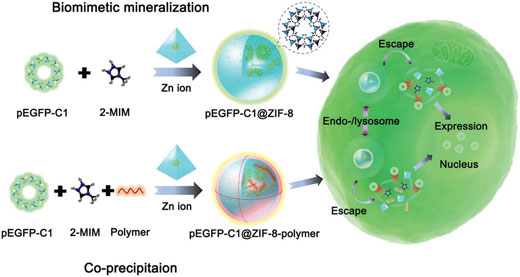| Jun 13, 2019 | |
MOF-encapsulated DNA for gene therapy |
|
| (Nanowerk Spotlight) Gene therapy is the process of adding or replacing missing or defective genes in a patient's cells in order to treat gene-based diseases such as certain types of cancer, hemophilia, muscular dystrophy, and immune deficiencies. | |
| A critical challenge in gene therapy is the safe and effective delivery of genetic materials across cell membranes into target cells. So far, most approaches have relied on modified viruses, external electrical fields or harsh chemicals. These methods can be costly, inefficient or cause undesirable stress and toxicity to cells. | |
| Although viral systems have been the most effective method for delivering genetic matter into cells, they pose significant safety problems. This has led researchers to explore nanoscale organic (e.g. liposomes, polymers, peptides) and non-organic (e.g. various metal nanoparticles, nanodiamonds and carbon nanotubes) non-viral delivery systems. | |
| "Despite the progresses and improvements made in the design and desired properties of the nonviral vectors, there are still many challenges ahead, including the toxicity of residual catalysts used in the synthesis of organic vectors, the tedious synthesis process of inorganic vectors for nucleic acids loading, and the limited understanding for their efficient gene expression," explains Professor Zhiyong Tang from the National Center for Nanoscience and Technology, CAS Key Laboratory of Nanosystem and Hierarchical Fabrication, Beijing. "Therefore, it is necessary to develop novel nonviral vectors with facile synthetic preparation, better biocompatibility and biodegradability, and higher expression efficacy." | |
| Demonstrating an example for such a novel delivery vector, Tang and his team of collaborators have developed a facile one-pot strategy to encapsulate plasmid DNA into nanoscale metal-organic frameworks (MOFs) and a MOF-polymer system via the biomimetic mineralization and co-precipitation method, respectively. | |
| The researchers report their findings in Advanced Materials("Encapsulation of Plasmid DNA by Nanoscale Metal–Organic Frameworks for Efficient Gene Transportation and Expression") | |
 |
|
| Schematic representation of synthesis of pEGFP-C1@ZIF-8 nanostructures and pEGFP-C1@ZIF-8-polymer nanostructures via biomimetic mineralization and co-precipitation method, respectively, and their cellular delivery and expression process. (Reprinted with permission by Wiley-VCH Verlag) (click on image to enlarge) | |
| MOFs have emerged as a promising platform in biomedical applications. For instance, we recently reported on magnetically propelled MOFBOTs perform microrobotic drug delivery and their role in enhancing sonodynamic cancer therapy. | |
| "The use of MOFs as potential nonviral vectors for intracellular delivery of proteins, DNA, or RNA is still in the preliminary stage," Tang tells Nanowerk. "Moreover, the focus of intracellular investigations is centered on utilizing low molecule weight oligonucleotide combined with MOFs or MOF-polymer systems, which is not applicable for nucleic acids with high molecule weight to be delivered safely and efficiently." | |
| Plasmid DNA (pDNA), with its large rope like loop structure and high molecule weight (above 4000 bp) has been widely investigated to evaluate the gene transfer capacity of varied vectors based on its gene expression. | |
| However, researchers have encountered numerous challenges in large DNA molecule delivery, including the high cost and toxicity in the synthesis of organic vectors and the tedious synthesis process, especially for inorganic vectors modified with polymer capping agents. | |
| Demonstrating a promising alternative synthesis method, the team led by Tang developed a rapid and economical one-pot method to encapsulate large pDNA molecules – plasmid DNA expressing enhanced green fluorescent protein (pEGFP-C1) – into ZIF-8 and ZIF-8-polymer vectors. | |
| ZIF-8 is a member of the MOF family and is popular with biomedical researchers due to its excellent biocompatibility and degradation characteristics in relatively mild acidic conditions. | |
| The researchers' experiments showed that pDNA molecules could be well distributed throughout the MOF nanostructures and benefited from effective protection against the enzymatic degradation. | |
| Tang says that the pDNA could be well loaded, released and protected in both the MOF and MOF-polymer systems. "Impressively, the protected pDNA exhibits the high efficacy of intracellular gene expression, particularly within the ZIF-8-polymer vector." | |
| This work not only offers a rapid and convenient way to load gene molecules into nanostructures for effective intracellular transportation and expression, but also opens a new avenue to develop MOF-based non-viral vectors for various gene therapies, such as RNA silencing, DNA vaccines and immunotoxin treatment. | |
 By
Michael
Berger
– Michael is author of three books by the Royal Society of Chemistry:
Nano-Society: Pushing the Boundaries of Technology,
Nanotechnology: The Future is Tiny, and
Nanoengineering: The Skills and Tools Making Technology Invisible
Copyright ©
Nanowerk LLC
By
Michael
Berger
– Michael is author of three books by the Royal Society of Chemistry:
Nano-Society: Pushing the Boundaries of Technology,
Nanotechnology: The Future is Tiny, and
Nanoengineering: The Skills and Tools Making Technology Invisible
Copyright ©
Nanowerk LLC
|
|
|
Become a Spotlight guest author! Join our large and growing group of guest contributors. Have you just published a scientific paper or have other exciting developments to share with the nanotechnology community? Here is how to publish on nanowerk.com. |
|
